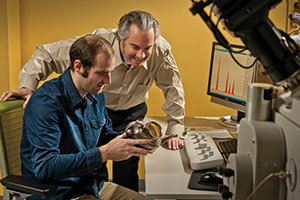March 28, 2014
Innovation and education

Adam Wilson (Photo courtesy of Adam Wilson)
UNT's biocultural conservation work in Chile includes the "Tracing Darwin's Path" study abroad course, one of the first programs supported by a 100,000 Strong in the Americas grant. Students learn about the importance of preserving the diversities of life while studying in the UNESCO Cape Horn Biosphere Reserve, one of the world's last pristine wilderness areas (pictured above). This program and other innovative research initiatives at UNT are featured in the 2014 UNT Research magazine.
"Our students learn from faculty pushing the boundaries of knowledge and discovery through funded research," says Tom McCoy, vice president for research and economic development.
"And they have access to state-of-the-art equipment purchased through competitive awards that our faculty have earned."
Can we engineer a better future?

2014 UNT Research magazine cover
Researchers in the fast-growing College of Engineering are working on innovative technology in a variety of fields -- from a patented Stirling engine that draws energy from temperature changes rather than fossil fuels, to a fabric that could sense cardiac troubles and a companion robot designed to help senior citizens overcome depression. A new biomedical engineering program will increase students' opportunities for hands-on research solving real-world issues.
Honors College research

From left, Corina Gomez and Irene Klaver (Photo by Jonathan Reynolds)
Students in the Honors Research Track are inspired by faculty mentors who guide them in their work. Senior Corina Gomez, left, and her mentor, Irene Klaver, professor of philosophy and religion studies and director of the Philosophy of Water Project. When Gomez was searching for a thesis topic in Klaver's "Philosophy of Water" class, Klaver suggested she look at how the Latino population has been affected by water issues. Gomez examined how Dallas' beautification of the Trinity River affected residents of Oak Cliff. She hopes to pursue a master's and law degree in environmental policy.
Art meets science

From left, Matthew Carl and Marcus Young ('97) (Photo by Jonathan Reynolds)
UNT researchers mix science with creativity, pushing the boundaries of their fields. Marcus Young ('97), art alum and assistant professor of materials science and engineering, and graduate student Matthew Carl are the first to use a focused ion beam system to examine metal museum artifacts -- a novel technique they developed to learn about the manufacturing of silver and silver-plated pieces from the Dallas Museum of Art.